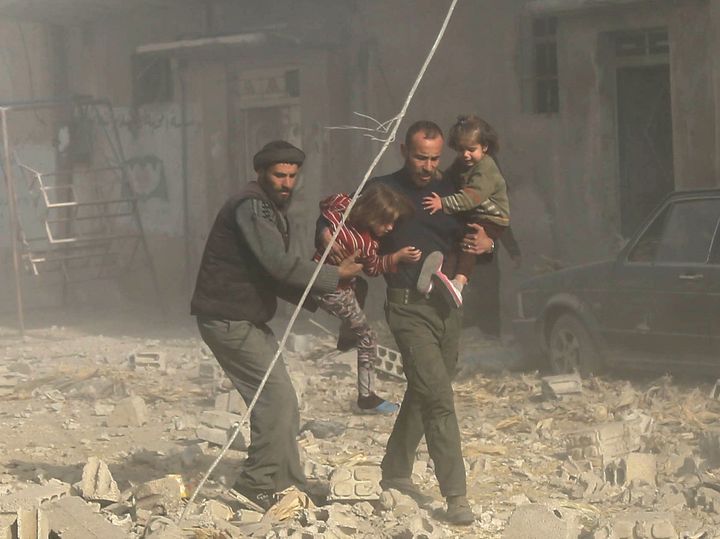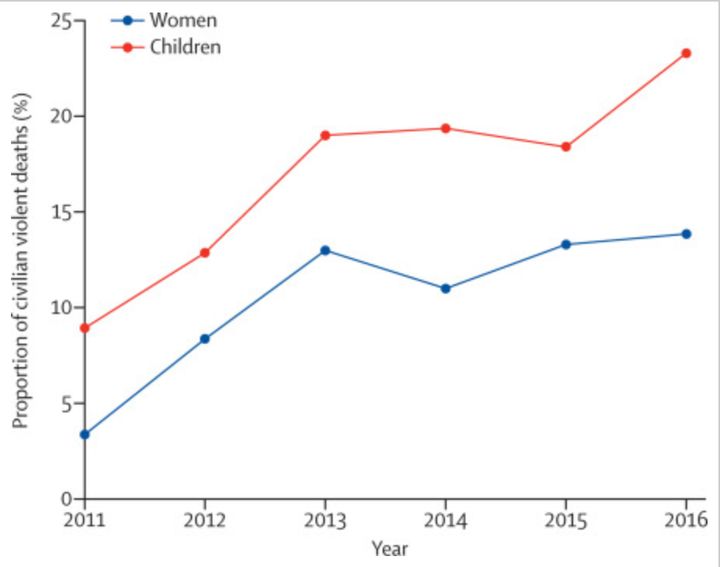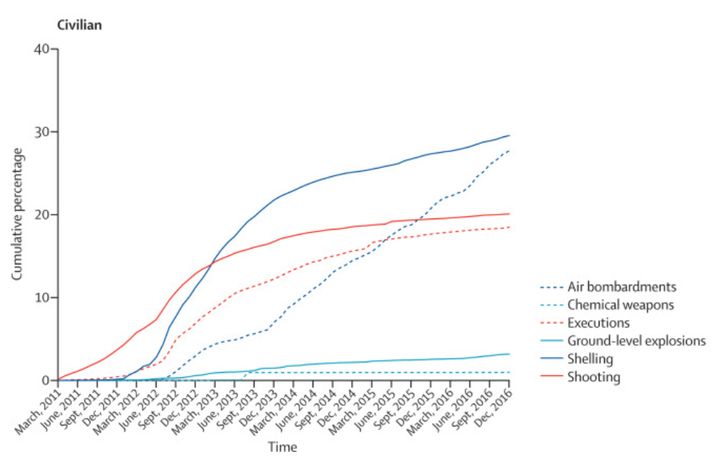Nearly one in four civilian deaths in Syria last year involved a child, a study has revealed, amid warnings that the war is having “a disproportionate lethal impact on civilians, particularly children” and claims war crimes are being committed.
Civilians accounted for 71% of the 143,630 deaths in the first six years of the conflict, a report published in Lancet Global Health noted, while 29% were opposition fighters.
Since 2011, the proportion of child civilian casualties has increased from 8.9% (388) of 4,354 civilian deaths, to 19% (4927) in 2013 and 23.3% (2262) of 11,444 in 2016. Civilian women accounted for 1,582 deaths last year.
More than 17,000 children have been directly killed by weapons - including guns, ground explosives and air bombs - since the civil war began, researchers said. The Syrian Network for Human Rights put that figure at 26,446 as of September 2017.

The study comes as HuffPost UK this week launched a Christmas appeal to help children impacted by the Syrian war, part of which saw two reporters travel there to speak with seven children who delivered heartbreaking messages to the world.
Since the conflict began in March 2011, life expectancy rates have dropped by as much as 20 years and more than half of the population had been displaced, researchers said.
The Lancet report noted it had likely underestimated the death toll as its researchers were only able to get reliable data from areas not controlled by the Syrian government. The figures also don’t account for deaths caused indirectly by war, such as increased disease or medical shortages, or fatalities among those who had been detained or had disappeared.

The report, based on conflict-related deaths recorded by the Violations Documentation Center (VDC), said “increased reliance on aerial bombing by the Syrian government and international partners” was disproportionately affecting those under 18.
The report follows recent calls for UN member states to urgently review military rules of engagement in Syria following a record number of civilians deaths by explosive weapons last year.
Researchers noted that deaths from barrel bombs “were overwhelmingly civilian rather than opposition combatants, suggesting indiscriminate or targeted warfare contrary to international humanitarian law and possibly constituting a war crime”.
The study found:
“Aerial bombing and shelling rapidly became primary causes of direct deaths of women and children and had disproportionate lethal effects on civilians, calling into question the use of wide-area explosive weapons in urban areas.
“Increased reliance on aerial bombing by the Syrian Government and international partners is likely to have contributed to findings that children were killed in increasing proportions over time, ultimately comprising a quarter of civilian deaths in 2016.
“The inordinate proportion of civilians among the executed is consistent with deliberate tactics to terrorise civilians. Deaths from barrel bombs were overwhelmingly civilian rather than opposition combatants, suggesting indiscriminate or targeted warfare contrary to international humanitarian law and possibly constituting a war crime.”
Professor Debarati Guha-Sapir of the University of Louvain’s public health health faculty, the study’s lead author, told the Guardian: “Our findings underscore the highly limited efficacy of shelling and aerial bombing against opposition fighters, and the disproportionate lethal impact on civilians, particularly children.
“These findings call into question the use of these weapons in populated urban areas and suggest possible indiscriminate weapons use contrary to international humanitarian law, the professor of epidemiology at Université catholique de Louvain in Brussels said.

More than half, 57% of civilian deaths were caused by airstrikes and shelling, compared with 10% of opposition fighters, the study found.
However, while male civilians were killed in equal numbers by airstrikes, shells, shootings and executions, women and children were mainly killed by shells and airstrikes. That increased from 2014 onwards as the use of these weapons grew when international parties intensified the aerial bombing, researchers said.
The study was particularly critical of the use of barrel bombs, with civilian deaths accounting for about 97% - a quarter of which involved children - of all fatalities associated with them.
Barrel bombs
Among the explosive weapons used, the impact of barrel bombs on civilians, compared with their relatively small effect on combatants, was striking.
Barrel bombs can cause three times as many injuries to survivors as do rockets and missiles, and cause higher numbers of deaths.
They were dropped by Syrian Government forces on hospitals, markets, and homes.
A first barrel bomb was sometimes followed by a second bomb dropped minutes later in a so-called double-tap strike to eliminate first responders and medical services.
Our study shows that by the end of 2016, more than a quarter of all civilians killed by barrel bombs were children, with the highest numbers in Aleppo, Idlib, and Daraa.
Guha-Sapir said the impact of barrel bombs on civilians supports claims that the weapons have been used to directly target them and said the international community had to share responsibility.
“They have to face the consequences that the bombing deaths have much more impact on civilians and an increasing proportion of children. This is against the laws of war,” she told the Guardian.
The US-led coalition battling the so-called Islamic State has claimed its strikes in Syria and Iraq have killed 800 civilians since its campaign began in 2014. That figure is disputed by Human rights groups.
Displacement figures
By late 2016, 6·3 million Syrians were internally displaced, with an estimated 6100 newly displaced people daily.
Over 1 million fled to Europe and an additional 5 million are refugees living in neighbouring countries, of whom 2·4 million are children.
Among Syrians unable to escape the violence, over 1 million have been injured and hundreds of thousands have died from indirect and direct effects of war, resulting in a drop in life expectancy of up to 20 years by 2014.
The UK-based, Syrian Network for Human Rights, estimates that 81% of children died in attacks by Syrian government forces. Russian forces were calculated to be behind 5.8% of child deaths.
Death by weapon type:
Patterns of death differed substantially between demographic groups, changing over the period of the conflict.
Civilian men died mostly from shooting from March, 2011, to January, 2014, after which point most died from shelling.
By contrast, the primary cause of violent deaths of civilian women and children shifted from shooting to shelling earlier in the conflict, beginning in August, 2012.
Air bombardment deaths of women and children increased more rapidly than among men, becoming the leading cause of death for civilian women and children by September, 2016.
By the end of 2016, 22 095 (77·5%) of 28 513 civilian women and children killed had resulted from wide-area explosive weapons, with 10 767 (37·8%) of all deaths caused by shelling and 11 328 (39·7%) caused by air bombardments.

